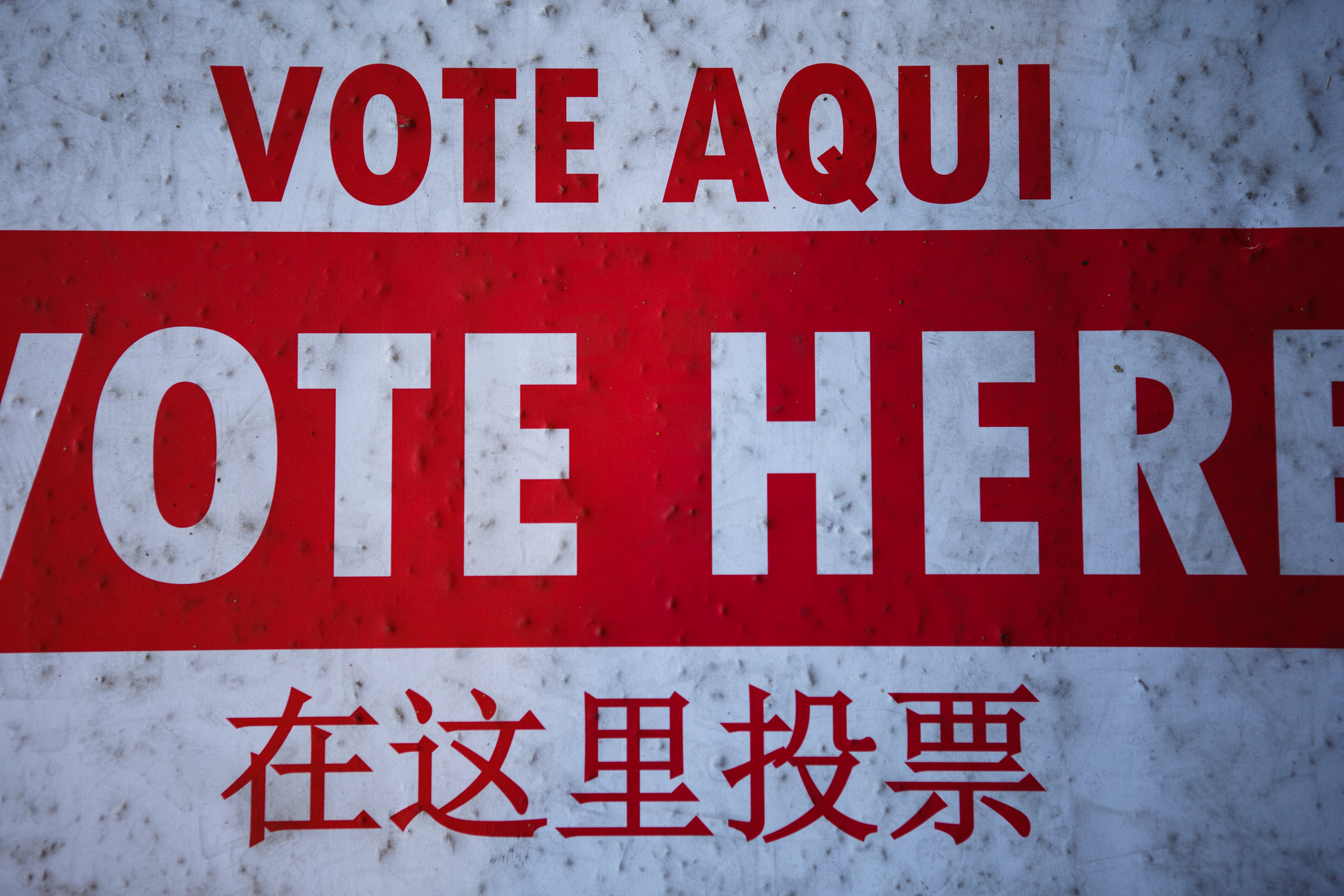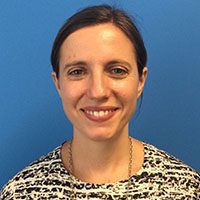
In some states, August is not just vacation time, but voting time. (Photo by Keith Lane for The Washington Post via Getty Images)
American democracy has been on a roll. Over the past few weeks, courts across the country have affirmed that we are better when everyone participates and each voter’s voice is heard.
Voter-ID laws, designed to suppress the vote, have been taking a beating. In Texas, North Carolina and North Dakota, courts struck down or modified voter-ID laws that make it harder for low-income, minority and student voters to cast their constitutionally protected ballots. A similar victory in Wisconsin is in limbo after a federal appeals court stayed the lower-court ruling pending appeal. With these decisions, the courts — including one of the most conservative appellate circuits in the land — announced that vote suppression tactics limiting Americans’ right to vote won’t be tolerated. It’s a win for voters, and a win for democracy.
But pernicious laws aren’t the only things standing in the way of a robust and active democracy. Anyone who takes a minute to reflect on our election season so far would do well to ask, what more needs to be done? Turnout for presidential elections barely pushes 60 percent on a good day — see President Obama’s first election in 2008 — and turnout for primaries pales in comparison. This year, 28.5 percent of eligible citizens voted in presidential primaries. While that figure seems shockingly low, it’s on the higher end of the spectrum; participation in the 2008 primaries reached a record level of 30.4 percent.
And, believe it or not, primary season isn’t over. This August, when many families are hitting the road or the beach for a last summer fling before school starts, 12 states are holding primary elections to pick nominees for fall House and Senate contests. On Tuesday alone, voters are going to the polls to nominate congressional candidates in South Dakota, Wyoming and Alaska. The outcomes of these races are important — just ask Barack Obama and his predecessor, George W. Bush, what a difference a Congress can make. Many of the states where voters are being asked to go to the polls to choose members of Congress already held presidential primaries earlier this year.
In a country where participation in primaries is consistently so low that it landed the United States 138th place out of 169 democracies in an international evaluation of turnout, one has to wonder if voter confusion might not be one of the factors involved. Consider:
In New York’s 1st Congressional District, 45,636 Democratic voters turned out to cast ballots in the April presidential primary. For June’s competitive congressional Democratic primary, the figure was 12,641. The drop-off was similarly abysmal in the state’s 22nd Congressional District among Republicans: 67,505 voted in the presidential primary. But in a hotly contested June GOP congressional primary, just 23,250 Republican voters turned out. (And New Yorkers might be surprised to learn that they have yet another primary ballot to cast, on Sept. 13, for state and local candidates).
In Missouri’s 1st Congressional District, which includes the city of St. Louis and much of St. Louis County, 147,597 Democrats voted in the March presidential primary. For last week’s three-way Democratic primary for the US House seat, the number of Democrats voting was 89,182. In Missouri’s heavily Republican 4th Congressional District, 130,638 Republicans cast ballots in the presidential primary, compared to 101,888 for the district’s three-way GOP congressional primary.
Much needs to be done on voter registration reform; states with same-day registration have significantly higher turnout rates in both general and primary elections, and a new reform — automatic voter registration — has the potential to raise those numbers further.
Full restoration of the protections of the Voting Rights Act, earlier gutted by the Supreme Court’s decision in Shelby Co. v. Holder, would prevent additional suppressive laws from hitting state books; the Voting Rights Advancement Act before Congress would ensure no voter’s ballot could be blocked by discrimination. These fixes aside, there’s more we should do to address how the primary system itself ensures all eligible Americans come together to select each party’s nominee.
In light of this year’s patterns during the primaries, three problems requiring solutions are at the top:
1. Everyone should participate, but caucuses discourage that.
If you want people to stay home, throw a caucus. When voting at a caucus, typically you have to spend a few hours checking in, listening to speeches and then aligning with one candidate over another. Given this chunk of time, parents with child care responsibilities and workers pulling down late shifts often miss out on the chance to cast their votes. Moreover, not every state’s caucus ensures a secret ballot; some require that individuals physically gather around a candidate while being counted. Indeed, the rules can feel a bit “inside baseball.” As a result, caucuses typically attract political insiders over everyday Americans, leading to polarizing elections instead of down-the-middle selections.
During this past election season, caucus states had some of the lowest turnout compared with primary states. Aside from Iowa, which perpetually has held the nation’s first caucus in a presidential election year, and Idaho, whose unaffiliated voters can register with a party on Election Day, the remaining nine states with caucuses saw turnout under 15 percent — with at least half the states in the single digits. For their Democratic Party caucus, North Dakota’s voters turned out at an abysmal rate of 0.7 percent. With a system like this, only a privileged few decide for the many whose name should head the top of the ticket.
2. Voting should be accessible and secure, but early registration deadlines are an obstacle.
In some states — Minnesota, for example — an eligible citizen can both register and vote on the date of the primary, thereby permitting those who aren’t as politically involved to still choose a nominee. Most states, though, don’t permit that option, and most impose deadlines by which a registered voter must change his or her affiliation in order to vote a different ticket in the primary. New York state, taking that rule to the extreme, requires an individual to make such a change 193 days before its April primary, so it’s no surprise that turnout in New York hovered at around 20 percent. Few people pay attention to the election that far out, and fewer still have chosen a candidate by the deadline. This is especially troubling for the growing number of Americans who identify as independent, aligning themselves with a candidate rather than a party.
3. Our current primary schedule consistently benefits some voters to the detriment of others.
Not surprisingly, New Hampshire, the second state to vote (right after Iowa’s caucuses) and home of the first primary of the season, boasted the highest voter turnout with 53 percent — a figure well above most other states, which hover between 20 and 30 percent turnout. Because they hold the first primary and caucus respectively, New Hampshire and Iowa get the most attention from the media and candidates alike, and its reflected in the turnout stats. The old saying may be, “as New Hampshire goes, so goes the nation,” but a state with under 1.5 million residents, 94 percent of whom are white, does not represent this country as a whole. New Hampshire’s golden spot during the presidential elections gives it unfair advantage in candidate selection over the rest of the states — and the rest of Americans.
When it comes to selecting elected officials, Americans pay the most attention during presidential election years. States know and capitalize on this; most keep moving primary and caucus dates up in a race to get to the top of the pack — garnering media and candidate attention, not to mention campaign dollars. A more appropriate spacing, perhaps even a rotating schedule among the states, would also make it possible to schedule down-ballot elections for the same date — ensuring that more citizens vote for the offices that impact them most.
Our current primary system gets berated each election season, with good reason. It doesn’t work well. If we want to truly raise our turnout rates, and ensure that all eligible Americans are participating, we’ve got to come up with solutions. Otherwise, come the presidential election, 60 percent turnout will still look pretty good.




